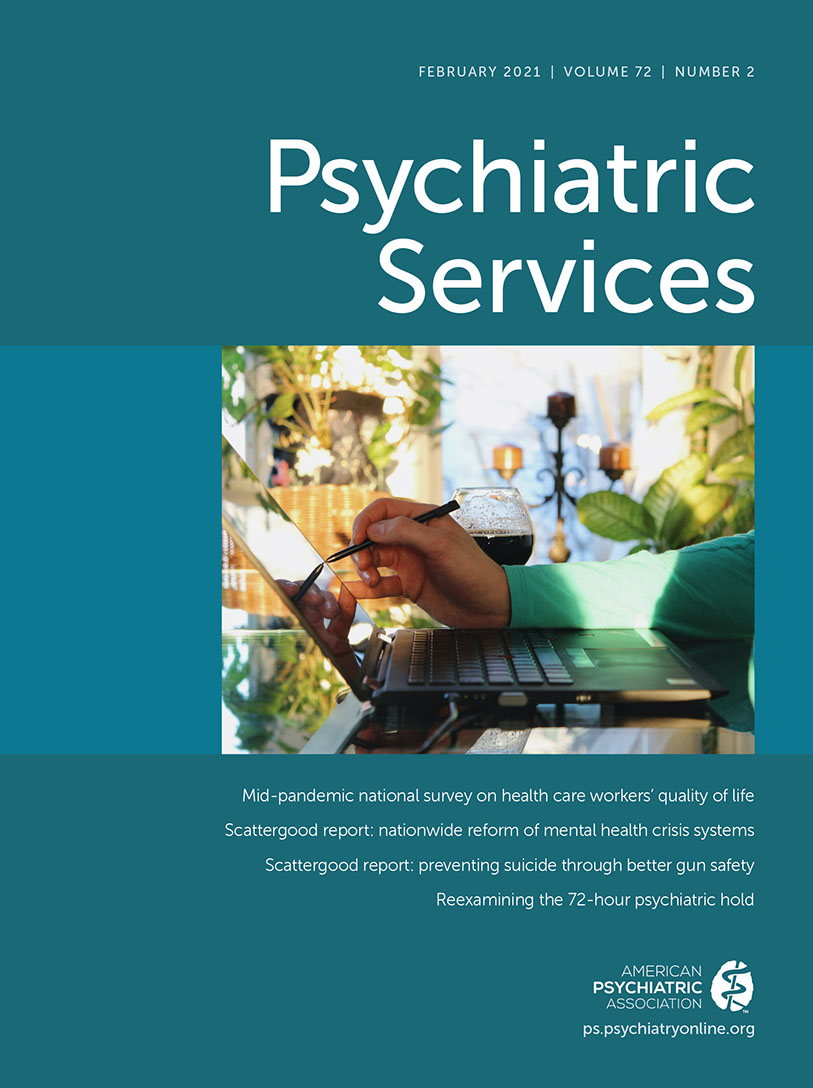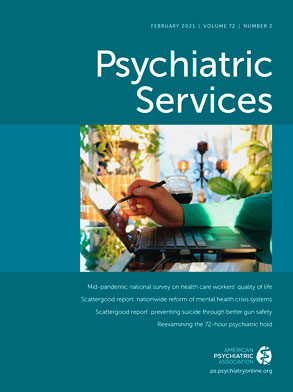With the rollout of depression screening programs in pediatric primary care (
1), and in accordance with recommendations to conduct universal adolescent depression screening (
2), suicidality items on these screeners will help detect an increasing number of adolescents at risk for suicide. Furthermore, the rising rate of youth suicide in the United States (
3) highlights a need for effective suicide assessment and prevention practices. Adolescence is a particularly crucial time to evaluate and target suicide risk given the increased prevalence of suicidal ideation, plans, and attempts during this period (
4). To address this public health crisis, efforts are under way to implement youth suicide screening and prevention in primary care (
5,
6). Although there is uncertainty as to whether widespread screening for suicide should take place in primary care (
7), such screening is likely to occur as long as universal adolescent depression screening remains part of routine care. Thus, it is critical to determine how to optimize adolescent suicide risk identification and management in the context of depression screening.
This study provides an opportunity to understand suicide risk detected via routine adolescent depression screening in pediatric primary care and the types of follow-up care that adolescents receive in the year following an endorsement of suicidality. Moreover, this study enables the examination of an amalgamation of suicide risk identification approaches in the literature (
8,
9) because suicidality was first determined by depression screening, and further assessment was then conducted with designated follow-up questions. Understanding the current suicide assessment and prevention landscape in primary care, including the proportion of adolescents at risk for suicide identified through depression screening, and the follow-up services that these adolescents receive will be crucial for informing best practices in this setting.
Suicide Assessment and Follow-Up in Primary Care
Primary care provides an opportunity to deliver screening and prevention services where individuals at risk for suicide are likely to present (
10). The U.S. Preventive Services Task Force released a statement in 2014 reporting that “the current evidence is insufficient to assess the balance of benefits and harms of screening for suicide risk . . . in primary care” (
7). Nonetheless, identification of suicide risk is often a natural consequence of adolescent depression screening, which is endorsed by the U.S. Preventive Services Task Force (
2). Understanding suicide risk rates and follow-up procedures in the context of depression screening is critical for elucidating necessary modifications to make system-wide adolescent suicide screening suitable and sustainable.
After a suicide risk is identified, the literature recommends several follow-up actions that primary care providers (PCPs) may use (
11). Research demonstrates that data extraction from electronic health records (EHRs) may underestimate rates of follow-up actions after a positive suicide screen (
5). Thus, we used a combination of EHR extraction and manual chart review in this study to gain an in-depth understanding of follow-up actions implemented when suicide risk was detected via depression screening.
Discussion
The findings of this study yield important information on suicide risk levels and on immediate assessment and short-term follow-up procedures by PCPs and other health care providers for adolescents endorsing suicidality in the context of depression screening in pediatric primary care. The rate of lifetime suicide attempts was similar to the prevalence reported in epidemiological research with adolescents, whereas the prevalence of suicidal ideation was lower in our sample (
4), likely because of our focus on serious ideation in the past month. Few adolescents endorsed suicidality in the past week. Thus, the rate and severity of suicide risk detected via adolescent depression screening in primary care seem relatively manageable. Additionally, our findings reaffirm that suicidality occurs across the depression spectrum. Therefore, detailed assessment of suicide risk is advisable even in the absence of elevated depression symptoms. These results highlight the utility of including suicidality questions within depression screeners, in addition to providing PCPs with structured follow-up assessment tools, demonstrating how merging existing approaches with suicide risk identification (
8,
9) can further prepare pediatric PCPs to identify and assess suicide risk that may otherwise be overlooked. Additionally, efforts to enhance depression screening rates are likely to have an important ripple effect for improved identification of suicide risk.
PCPs conducted the follow-up suicide risk questions with a high degree of fidelity, suggesting the feasibility of implementing suicide assessment procedures in a large health system and the benefits of doing so within the EHR context. Yet, for about a quarter of adolescents, documentation of any of the follow-up questions was missing. Numerous factors (e.g., time and provider knowledge and comfort) likely affected implementation of suicide assessment and follow-up procedures. Further research is needed to systematically identify barriers and facilitators to implementing suicide assessment and follow-up care protocols in primary care.
Beyond the suicide assessment questions, suicide-specific follow-up actions were relatively sparse in the year after PHQ-9-M screening per a retrospective manual chart review. The benefits of widespread suicide assessment cannot be fully realized without such assessment being converted to consistent, appropriate follow-up care. Perhaps the low frequencies of certain follow-up actions can be attributed to adolescents’ limited endorsement of suicidality in the past week. Nonetheless, only a small subset of adolescents had documented safety planning or were given a crisis number, and even fewer received both. Of note, PCPs had access to a handout that listed behavioral health resources (e.g., the National Suicide Prevention Lifeline). Thus, our manual chart review likely underestimates follow-up actions that were covered in the handout but not necessarily documented in patients’ charts.
Behavioral health referrals were recorded for a subset of the sample of adolescents. It is possible that for some adolescents, particularly those exhibiting low depression symptoms and more remote suicide risk, referrals were not indicated. Nonetheless, from a prevention standpoint, especially given what is known about the recurrence and escalation of suicidality among adolescents (
20), it would be ideal for all adolescents to receive referrals at the first sign of suicide risk should they require future services.
Most adolescents participating in therapy were enrolled in treatment before their PHQ-9-M screening. The exact nature of these services was often unknown. Moreover, consultation between PCPs and adolescents’ behavioral health providers was rare and, even when it occurred, may not have related to suicidality. We conclude that some behavioral health providers might have remained unaware of adolescents’ suicide risk, particularly if the PHQ-9-M was their first disclosure of suicidality. Our results underscore the importance of enhancing communication between PCPs and behavioral health providers to ensure comprehensive, high-quality care.
Although the findings of this study can help refine youth suicide assessment and prevention efforts in primary care, particularly within the context of existing depression screening efforts, we acknowledge some limitations. The manual chart review subsample included only 23% of adolescents at risk for suicide on the basis of their responses to screener items and, therefore, represents preliminary information on the types of follow-up care that adolescents received following endorsement of suicidality. Replication with a larger sample, for example, across hospital systems, will aid understanding of the generalizability of these findings. Nonetheless, we note that our manual chart review sample size was consistent with, or larger than, those in several published studies that used retrospective chart review (
21,
22). Although suicide risk rates were similar for adolescents screened at their age-16 well-visit and for those of other ages, we cannot rule out the possibility that selective screening occurred for adolescents younger or older than 16 years.
Additionally, data on actual suicide attempts were unavailable; these data will be important to include in upcoming studies as a means to understand the effectiveness of primary care–based suicide screening and follow-up for reducing suicidal behaviors. An additional limitation is that lack of documentation in the EHR could not be distinguished from lack of follow-up (
1). Furthermore, without access to behavioral health notes, the rates of certain follow-up actions are likely underestimates. In future studies, researchers may benefit from using a multimethod approach (e.g., direct observations and qualitative interviews) to gain a comprehensive understanding of current practices and areas for improvement. Although reassuring from a patient safety perspective, the low rate of suicide risk in the week before screening hindered our ability to assess fidelity to the system’s emergency procedures. Future work that overselects for adolescents endorsing imminent suicide risk will be important for understanding follow-up actions taken in these higher-risk situations.
Conclusions
The findings from this study offer valuable insights into the feasibility of incorporating suicide follow-up questions within depression screening programs in pediatric primary care and highlight ways to enhance provider- and system-level practices that can mitigate the risk of adolescent death by suicide. Given the level of fidelity to the suicide follow-up questions, it seems likely that, if similarly incorporated into the EHR, evidence-based assessments such as the Columbia–Suicide Severity Rating Scale (
23) could replace existing procedures. Evidence-based suicide assessment provides an important guide for determining risk that may not be adequately captured through depression screening alone. Additionally, collaborative and integrated care models in which behavioral health providers, PCPs, families, and patients work together closely to address patient needs (
24) will be critical to handle the volume of suicide risk likely to be detected as adolescent depression screening programs continue to expand. Relatedly, a care navigator (i.e., someone who provides support in the initiation and maintenance of care) can help connect adolescents to mental health services and facilitate information sharing between providers and families (
25).
Building additional resources into the EHR system (e.g., safety planning templates) can also facilitate tailored referrals and intervention strategies for adolescents at risk for suicide, minimize bottlenecks in workflow, and enable EHR data extraction. Similarly, incorporating prepopulated text options into EHR note templates (e.g., SmartLists and SmartPhrases available within EHR systems such as Epic) can simplify documentation, clarify which suicide assessment and follow-up steps were implemented, and capture important outcomes. Electronic reminders to assess suicide risk and provide follow-up, along with functions that prohibit providers from closing a progress note until such actions are documented, may also be helpful. Taken together, refinements in suicide assessment, documentation, and linkages to care guided by the current findings may make a meaningful difference in the lives of adolescents, their families, and the providers who care for them.


